Enterprise Architecture, Strategy, and Governance Report: Insights
VerifiedAdded on 2020/05/11
|17
|4232
|193
Report
AI Summary
This report examines Enterprise Architecture (EA), Strategy, and Governance, focusing on implementation challenges and stakeholder relationships. It reviews EA literature, highlighting the importance of aligning IT portfolios with organizational strategy and the evolution of EA methodologies. The report identifies key challenges in successful EA implementation, including inadequate awareness of benefits, organizational politics, and conflicting stakeholder expectations. It analyzes the relationship between architects and stakeholders, emphasizing the need for effective communication and understanding of business requirements to avoid project failures. The report also explores the influence of architectural competencies on stakeholder involvement, discussing models like PED (Proactive Enterprise Development) and the critical success factors for EA implementation. It concludes by identifying areas where further research is needed, particularly in understanding the nature of stakeholder interactions and the role of architects in ensuring successful EA initiatives. The report is a valuable resource for understanding the complexities of EA and its impact on business development.
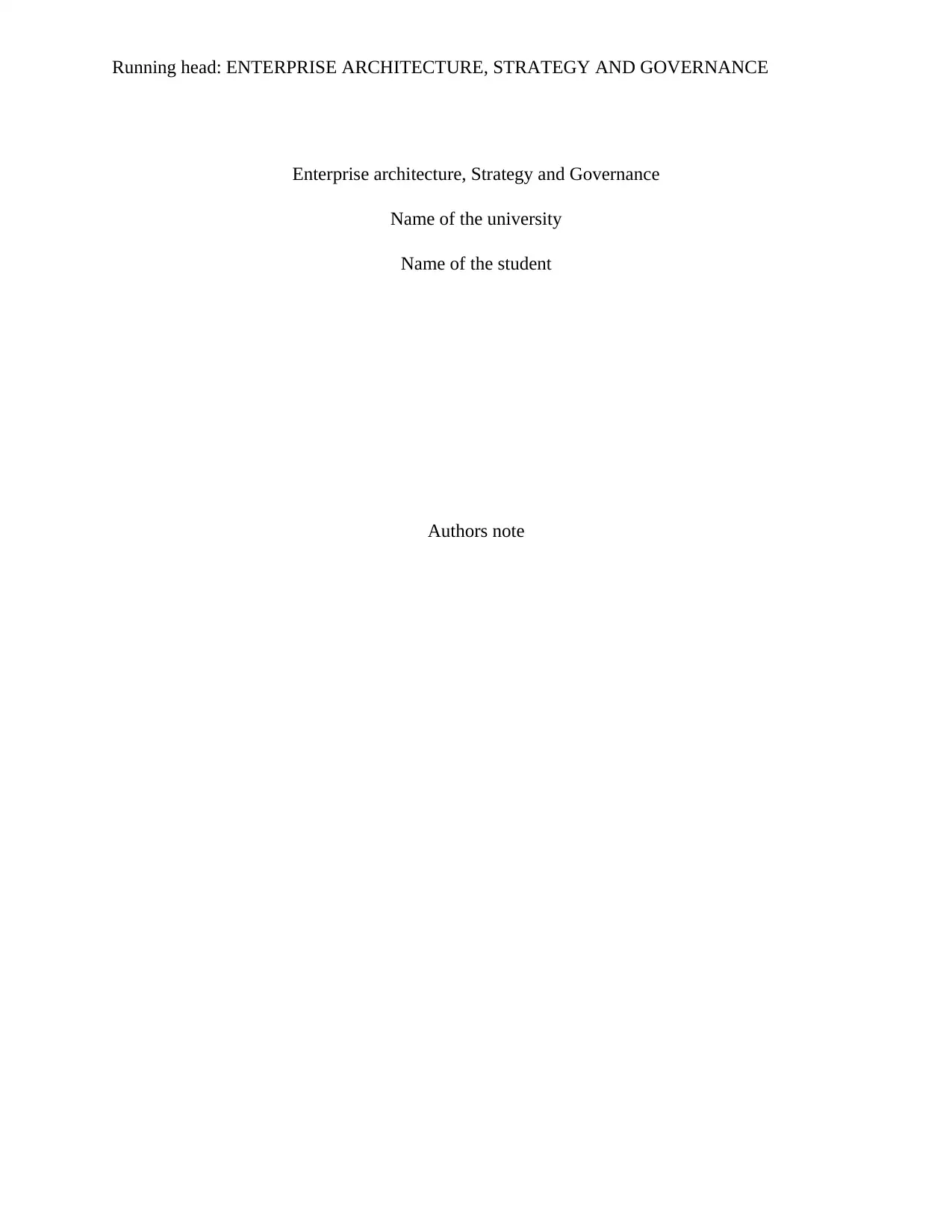
Running head: ENTERPRISE ARCHITECTURE, STRATEGY AND GOVERNANCE
Enterprise architecture, Strategy and Governance
Name of the university
Name of the student
Authors note
Enterprise architecture, Strategy and Governance
Name of the university
Name of the student
Authors note
Paraphrase This Document
Need a fresh take? Get an instant paraphrase of this document with our AI Paraphraser
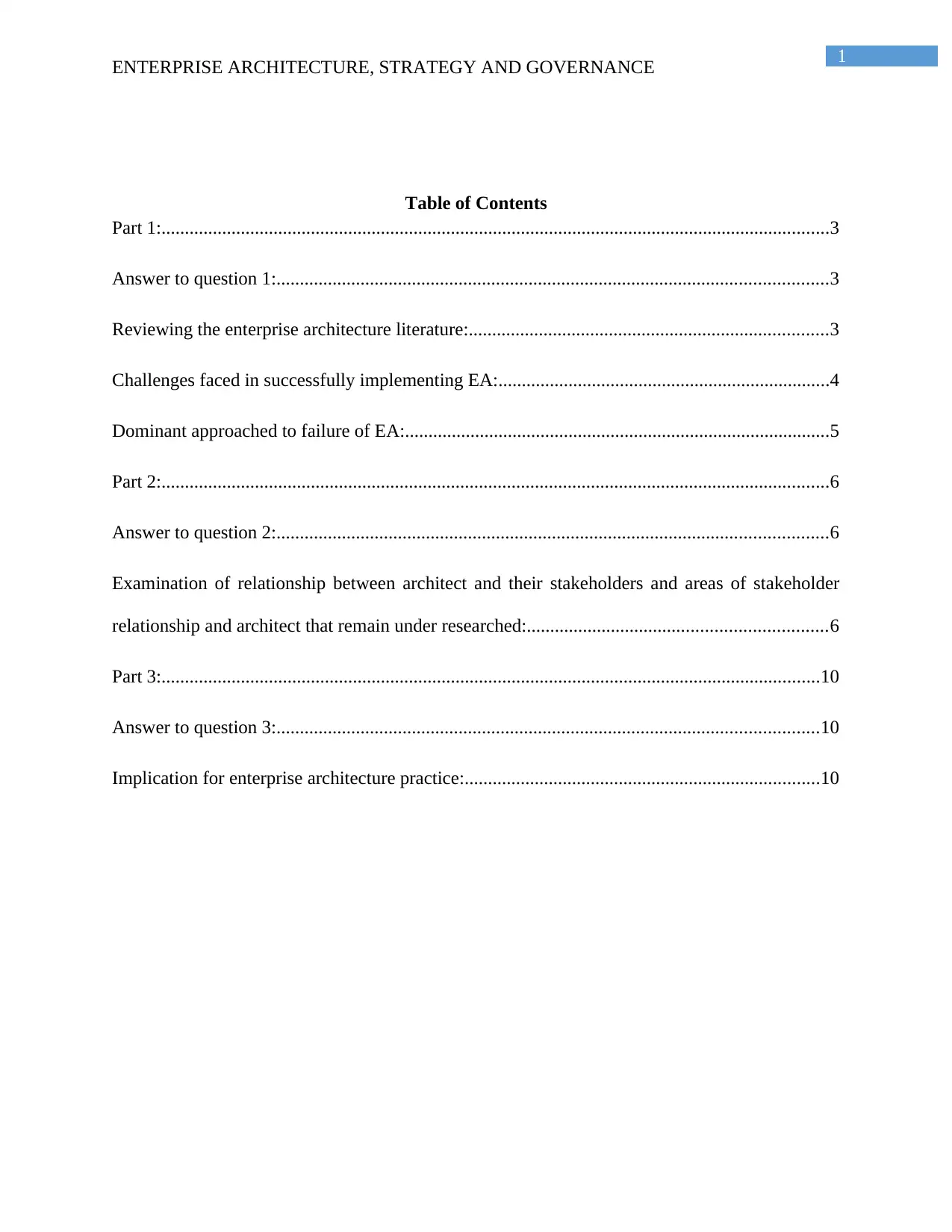
1
ENTERPRISE ARCHITECTURE, STRATEGY AND GOVERNANCE
Table of Contents
Part 1:...............................................................................................................................................3
Answer to question 1:......................................................................................................................3
Reviewing the enterprise architecture literature:.............................................................................3
Challenges faced in successfully implementing EA:.......................................................................4
Dominant approached to failure of EA:...........................................................................................5
Part 2:...............................................................................................................................................6
Answer to question 2:......................................................................................................................6
Examination of relationship between architect and their stakeholders and areas of stakeholder
relationship and architect that remain under researched:................................................................6
Part 3:.............................................................................................................................................10
Answer to question 3:....................................................................................................................10
Implication for enterprise architecture practice:............................................................................10
ENTERPRISE ARCHITECTURE, STRATEGY AND GOVERNANCE
Table of Contents
Part 1:...............................................................................................................................................3
Answer to question 1:......................................................................................................................3
Reviewing the enterprise architecture literature:.............................................................................3
Challenges faced in successfully implementing EA:.......................................................................4
Dominant approached to failure of EA:...........................................................................................5
Part 2:...............................................................................................................................................6
Answer to question 2:......................................................................................................................6
Examination of relationship between architect and their stakeholders and areas of stakeholder
relationship and architect that remain under researched:................................................................6
Part 3:.............................................................................................................................................10
Answer to question 3:....................................................................................................................10
Implication for enterprise architecture practice:............................................................................10
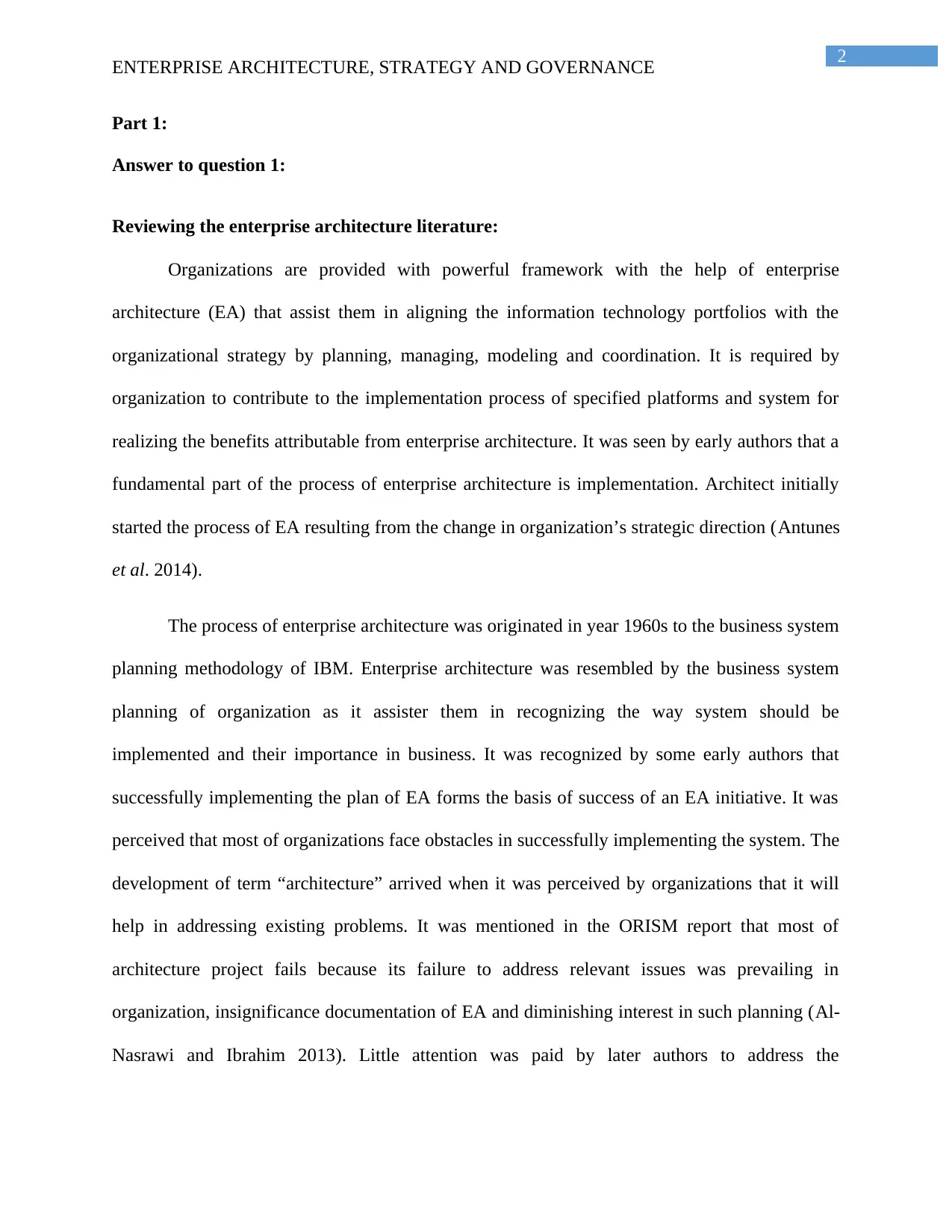
2
ENTERPRISE ARCHITECTURE, STRATEGY AND GOVERNANCE
Part 1:
Answer to question 1:
Reviewing the enterprise architecture literature:
Organizations are provided with powerful framework with the help of enterprise
architecture (EA) that assist them in aligning the information technology portfolios with the
organizational strategy by planning, managing, modeling and coordination. It is required by
organization to contribute to the implementation process of specified platforms and system for
realizing the benefits attributable from enterprise architecture. It was seen by early authors that a
fundamental part of the process of enterprise architecture is implementation. Architect initially
started the process of EA resulting from the change in organization’s strategic direction (Antunes
et al. 2014).
The process of enterprise architecture was originated in year 1960s to the business system
planning methodology of IBM. Enterprise architecture was resembled by the business system
planning of organization as it assister them in recognizing the way system should be
implemented and their importance in business. It was recognized by some early authors that
successfully implementing the plan of EA forms the basis of success of an EA initiative. It was
perceived that most of organizations face obstacles in successfully implementing the system. The
development of term “architecture” arrived when it was perceived by organizations that it will
help in addressing existing problems. It was mentioned in the ORISM report that most of
architecture project fails because its failure to address relevant issues was prevailing in
organization, insignificance documentation of EA and diminishing interest in such planning (Al-
Nasrawi and Ibrahim 2013). Little attention was paid by later authors to address the
ENTERPRISE ARCHITECTURE, STRATEGY AND GOVERNANCE
Part 1:
Answer to question 1:
Reviewing the enterprise architecture literature:
Organizations are provided with powerful framework with the help of enterprise
architecture (EA) that assist them in aligning the information technology portfolios with the
organizational strategy by planning, managing, modeling and coordination. It is required by
organization to contribute to the implementation process of specified platforms and system for
realizing the benefits attributable from enterprise architecture. It was seen by early authors that a
fundamental part of the process of enterprise architecture is implementation. Architect initially
started the process of EA resulting from the change in organization’s strategic direction (Antunes
et al. 2014).
The process of enterprise architecture was originated in year 1960s to the business system
planning methodology of IBM. Enterprise architecture was resembled by the business system
planning of organization as it assister them in recognizing the way system should be
implemented and their importance in business. It was recognized by some early authors that
successfully implementing the plan of EA forms the basis of success of an EA initiative. It was
perceived that most of organizations face obstacles in successfully implementing the system. The
development of term “architecture” arrived when it was perceived by organizations that it will
help in addressing existing problems. It was mentioned in the ORISM report that most of
architecture project fails because its failure to address relevant issues was prevailing in
organization, insignificance documentation of EA and diminishing interest in such planning (Al-
Nasrawi and Ibrahim 2013). Little attention was paid by later authors to address the
⊘ This is a preview!⊘
Do you want full access?
Subscribe today to unlock all pages.

Trusted by 1+ million students worldwide
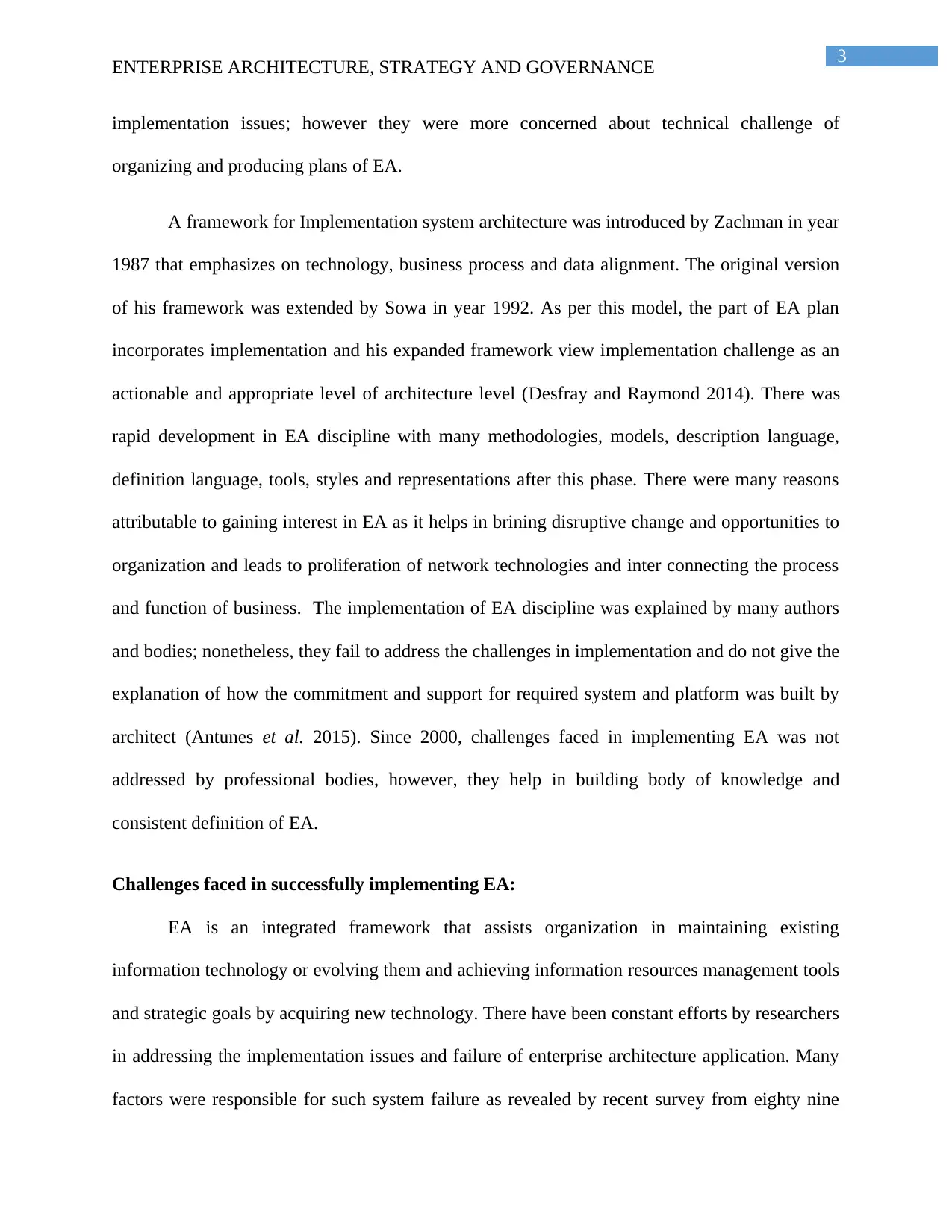
3
ENTERPRISE ARCHITECTURE, STRATEGY AND GOVERNANCE
implementation issues; however they were more concerned about technical challenge of
organizing and producing plans of EA.
A framework for Implementation system architecture was introduced by Zachman in year
1987 that emphasizes on technology, business process and data alignment. The original version
of his framework was extended by Sowa in year 1992. As per this model, the part of EA plan
incorporates implementation and his expanded framework view implementation challenge as an
actionable and appropriate level of architecture level (Desfray and Raymond 2014). There was
rapid development in EA discipline with many methodologies, models, description language,
definition language, tools, styles and representations after this phase. There were many reasons
attributable to gaining interest in EA as it helps in brining disruptive change and opportunities to
organization and leads to proliferation of network technologies and inter connecting the process
and function of business. The implementation of EA discipline was explained by many authors
and bodies; nonetheless, they fail to address the challenges in implementation and do not give the
explanation of how the commitment and support for required system and platform was built by
architect (Antunes et al. 2015). Since 2000, challenges faced in implementing EA was not
addressed by professional bodies, however, they help in building body of knowledge and
consistent definition of EA.
Challenges faced in successfully implementing EA:
EA is an integrated framework that assists organization in maintaining existing
information technology or evolving them and achieving information resources management tools
and strategic goals by acquiring new technology. There have been constant efforts by researchers
in addressing the implementation issues and failure of enterprise architecture application. Many
factors were responsible for such system failure as revealed by recent survey from eighty nine
ENTERPRISE ARCHITECTURE, STRATEGY AND GOVERNANCE
implementation issues; however they were more concerned about technical challenge of
organizing and producing plans of EA.
A framework for Implementation system architecture was introduced by Zachman in year
1987 that emphasizes on technology, business process and data alignment. The original version
of his framework was extended by Sowa in year 1992. As per this model, the part of EA plan
incorporates implementation and his expanded framework view implementation challenge as an
actionable and appropriate level of architecture level (Desfray and Raymond 2014). There was
rapid development in EA discipline with many methodologies, models, description language,
definition language, tools, styles and representations after this phase. There were many reasons
attributable to gaining interest in EA as it helps in brining disruptive change and opportunities to
organization and leads to proliferation of network technologies and inter connecting the process
and function of business. The implementation of EA discipline was explained by many authors
and bodies; nonetheless, they fail to address the challenges in implementation and do not give the
explanation of how the commitment and support for required system and platform was built by
architect (Antunes et al. 2015). Since 2000, challenges faced in implementing EA was not
addressed by professional bodies, however, they help in building body of knowledge and
consistent definition of EA.
Challenges faced in successfully implementing EA:
EA is an integrated framework that assists organization in maintaining existing
information technology or evolving them and achieving information resources management tools
and strategic goals by acquiring new technology. There have been constant efforts by researchers
in addressing the implementation issues and failure of enterprise architecture application. Many
factors were responsible for such system failure as revealed by recent survey from eighty nine
Paraphrase This Document
Need a fresh take? Get an instant paraphrase of this document with our AI Paraphraser
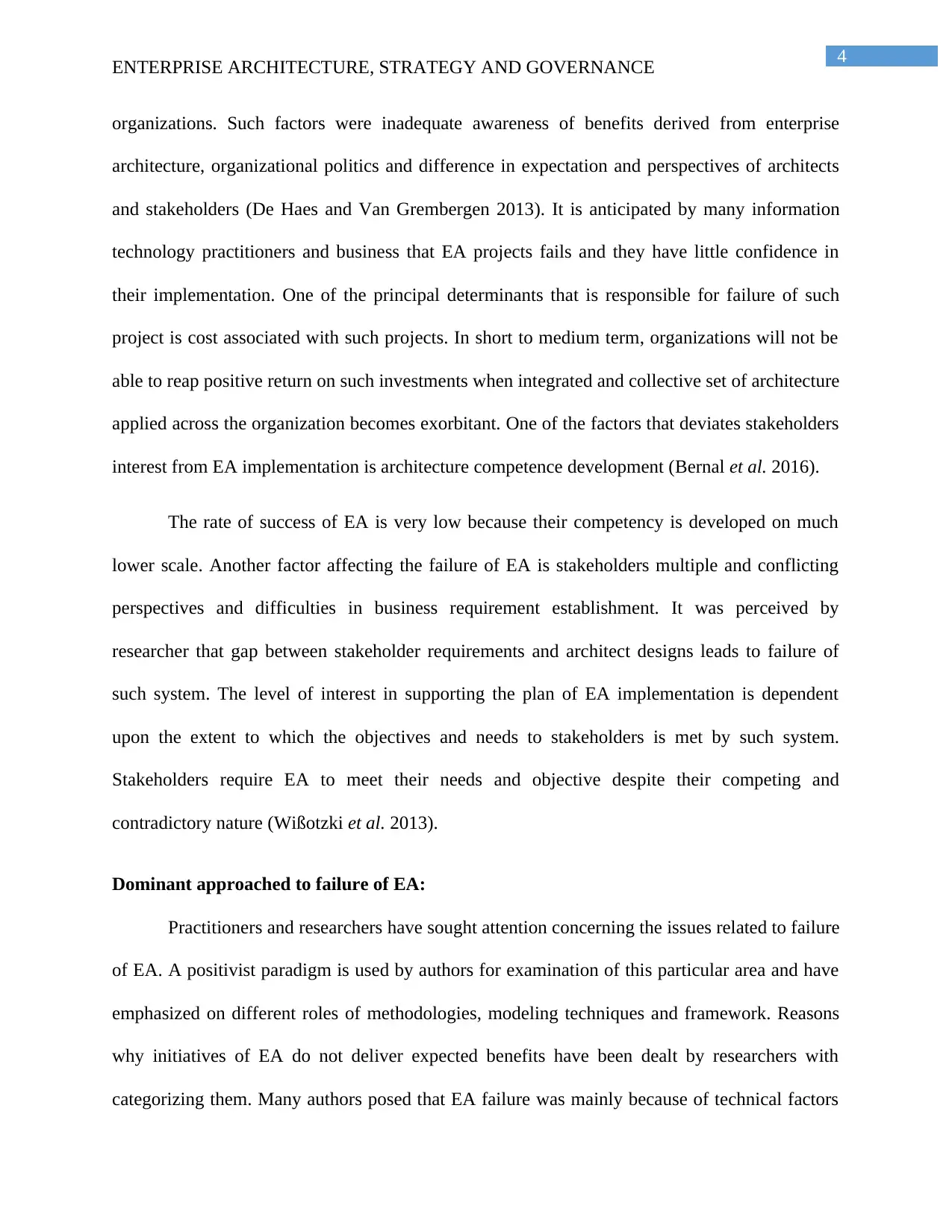
4
ENTERPRISE ARCHITECTURE, STRATEGY AND GOVERNANCE
organizations. Such factors were inadequate awareness of benefits derived from enterprise
architecture, organizational politics and difference in expectation and perspectives of architects
and stakeholders (De Haes and Van Grembergen 2013). It is anticipated by many information
technology practitioners and business that EA projects fails and they have little confidence in
their implementation. One of the principal determinants that is responsible for failure of such
project is cost associated with such projects. In short to medium term, organizations will not be
able to reap positive return on such investments when integrated and collective set of architecture
applied across the organization becomes exorbitant. One of the factors that deviates stakeholders
interest from EA implementation is architecture competence development (Bernal et al. 2016).
The rate of success of EA is very low because their competency is developed on much
lower scale. Another factor affecting the failure of EA is stakeholders multiple and conflicting
perspectives and difficulties in business requirement establishment. It was perceived by
researcher that gap between stakeholder requirements and architect designs leads to failure of
such system. The level of interest in supporting the plan of EA implementation is dependent
upon the extent to which the objectives and needs to stakeholders is met by such system.
Stakeholders require EA to meet their needs and objective despite their competing and
contradictory nature (Wißotzki et al. 2013).
Dominant approached to failure of EA:
Practitioners and researchers have sought attention concerning the issues related to failure
of EA. A positivist paradigm is used by authors for examination of this particular area and have
emphasized on different roles of methodologies, modeling techniques and framework. Reasons
why initiatives of EA do not deliver expected benefits have been dealt by researchers with
categorizing them. Many authors posed that EA failure was mainly because of technical factors
ENTERPRISE ARCHITECTURE, STRATEGY AND GOVERNANCE
organizations. Such factors were inadequate awareness of benefits derived from enterprise
architecture, organizational politics and difference in expectation and perspectives of architects
and stakeholders (De Haes and Van Grembergen 2013). It is anticipated by many information
technology practitioners and business that EA projects fails and they have little confidence in
their implementation. One of the principal determinants that is responsible for failure of such
project is cost associated with such projects. In short to medium term, organizations will not be
able to reap positive return on such investments when integrated and collective set of architecture
applied across the organization becomes exorbitant. One of the factors that deviates stakeholders
interest from EA implementation is architecture competence development (Bernal et al. 2016).
The rate of success of EA is very low because their competency is developed on much
lower scale. Another factor affecting the failure of EA is stakeholders multiple and conflicting
perspectives and difficulties in business requirement establishment. It was perceived by
researcher that gap between stakeholder requirements and architect designs leads to failure of
such system. The level of interest in supporting the plan of EA implementation is dependent
upon the extent to which the objectives and needs to stakeholders is met by such system.
Stakeholders require EA to meet their needs and objective despite their competing and
contradictory nature (Wißotzki et al. 2013).
Dominant approached to failure of EA:
Practitioners and researchers have sought attention concerning the issues related to failure
of EA. A positivist paradigm is used by authors for examination of this particular area and have
emphasized on different roles of methodologies, modeling techniques and framework. Reasons
why initiatives of EA do not deliver expected benefits have been dealt by researchers with
categorizing them. Many authors posed that EA failure was mainly because of technical factors
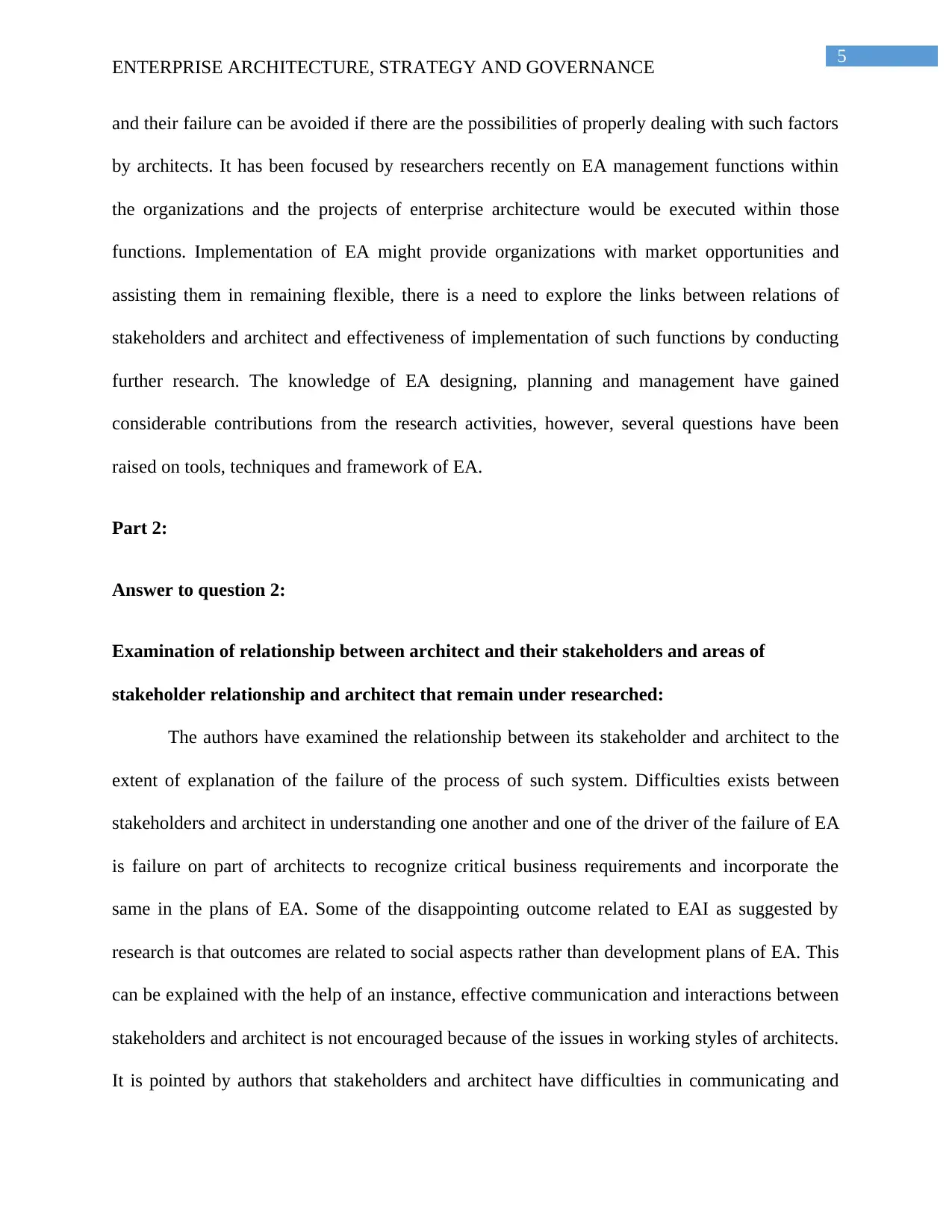
5
ENTERPRISE ARCHITECTURE, STRATEGY AND GOVERNANCE
and their failure can be avoided if there are the possibilities of properly dealing with such factors
by architects. It has been focused by researchers recently on EA management functions within
the organizations and the projects of enterprise architecture would be executed within those
functions. Implementation of EA might provide organizations with market opportunities and
assisting them in remaining flexible, there is a need to explore the links between relations of
stakeholders and architect and effectiveness of implementation of such functions by conducting
further research. The knowledge of EA designing, planning and management have gained
considerable contributions from the research activities, however, several questions have been
raised on tools, techniques and framework of EA.
Part 2:
Answer to question 2:
Examination of relationship between architect and their stakeholders and areas of
stakeholder relationship and architect that remain under researched:
The authors have examined the relationship between its stakeholder and architect to the
extent of explanation of the failure of the process of such system. Difficulties exists between
stakeholders and architect in understanding one another and one of the driver of the failure of EA
is failure on part of architects to recognize critical business requirements and incorporate the
same in the plans of EA. Some of the disappointing outcome related to EAI as suggested by
research is that outcomes are related to social aspects rather than development plans of EA. This
can be explained with the help of an instance, effective communication and interactions between
stakeholders and architect is not encouraged because of the issues in working styles of architects.
It is pointed by authors that stakeholders and architect have difficulties in communicating and
ENTERPRISE ARCHITECTURE, STRATEGY AND GOVERNANCE
and their failure can be avoided if there are the possibilities of properly dealing with such factors
by architects. It has been focused by researchers recently on EA management functions within
the organizations and the projects of enterprise architecture would be executed within those
functions. Implementation of EA might provide organizations with market opportunities and
assisting them in remaining flexible, there is a need to explore the links between relations of
stakeholders and architect and effectiveness of implementation of such functions by conducting
further research. The knowledge of EA designing, planning and management have gained
considerable contributions from the research activities, however, several questions have been
raised on tools, techniques and framework of EA.
Part 2:
Answer to question 2:
Examination of relationship between architect and their stakeholders and areas of
stakeholder relationship and architect that remain under researched:
The authors have examined the relationship between its stakeholder and architect to the
extent of explanation of the failure of the process of such system. Difficulties exists between
stakeholders and architect in understanding one another and one of the driver of the failure of EA
is failure on part of architects to recognize critical business requirements and incorporate the
same in the plans of EA. Some of the disappointing outcome related to EAI as suggested by
research is that outcomes are related to social aspects rather than development plans of EA. This
can be explained with the help of an instance, effective communication and interactions between
stakeholders and architect is not encouraged because of the issues in working styles of architects.
It is pointed by authors that stakeholders and architect have difficulties in communicating and
⊘ This is a preview!⊘
Do you want full access?
Subscribe today to unlock all pages.

Trusted by 1+ million students worldwide
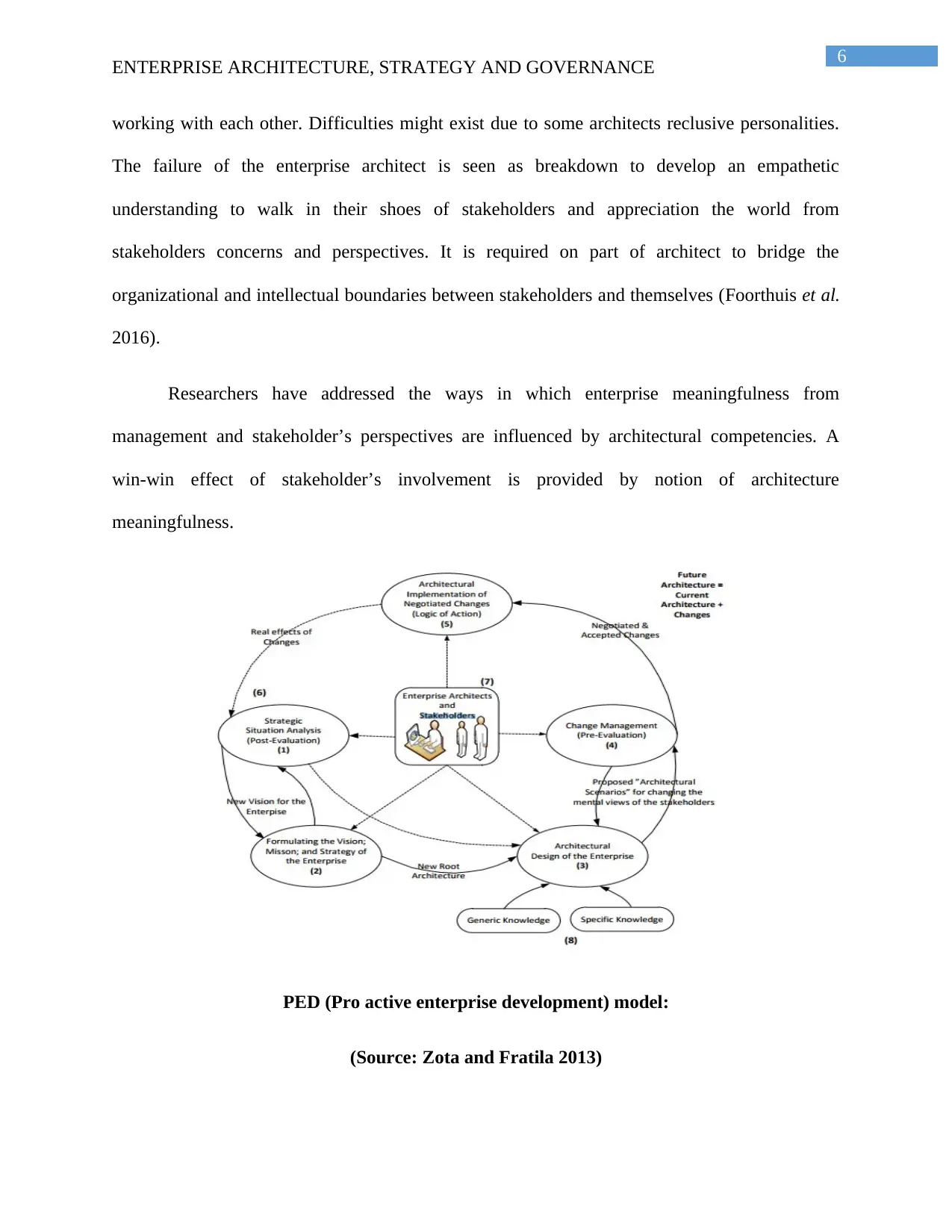
6
ENTERPRISE ARCHITECTURE, STRATEGY AND GOVERNANCE
working with each other. Difficulties might exist due to some architects reclusive personalities.
The failure of the enterprise architect is seen as breakdown to develop an empathetic
understanding to walk in their shoes of stakeholders and appreciation the world from
stakeholders concerns and perspectives. It is required on part of architect to bridge the
organizational and intellectual boundaries between stakeholders and themselves (Foorthuis et al.
2016).
Researchers have addressed the ways in which enterprise meaningfulness from
management and stakeholder’s perspectives are influenced by architectural competencies. A
win-win effect of stakeholder’s involvement is provided by notion of architecture
meaningfulness.
PED (Pro active enterprise development) model:
(Source: Zota and Fratila 2013)
ENTERPRISE ARCHITECTURE, STRATEGY AND GOVERNANCE
working with each other. Difficulties might exist due to some architects reclusive personalities.
The failure of the enterprise architect is seen as breakdown to develop an empathetic
understanding to walk in their shoes of stakeholders and appreciation the world from
stakeholders concerns and perspectives. It is required on part of architect to bridge the
organizational and intellectual boundaries between stakeholders and themselves (Foorthuis et al.
2016).
Researchers have addressed the ways in which enterprise meaningfulness from
management and stakeholder’s perspectives are influenced by architectural competencies. A
win-win effect of stakeholder’s involvement is provided by notion of architecture
meaningfulness.
PED (Pro active enterprise development) model:
(Source: Zota and Fratila 2013)
Paraphrase This Document
Need a fresh take? Get an instant paraphrase of this document with our AI Paraphraser
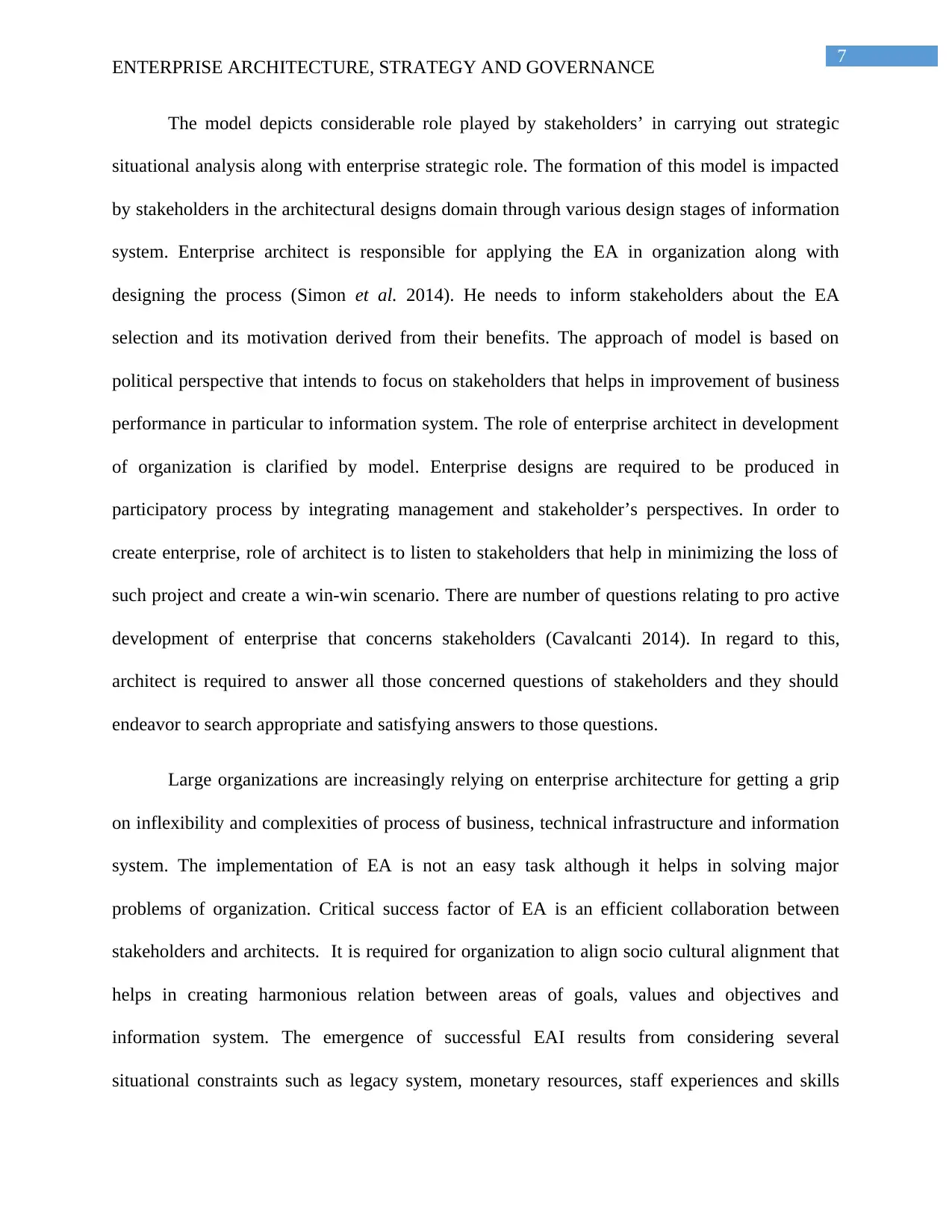
7
ENTERPRISE ARCHITECTURE, STRATEGY AND GOVERNANCE
The model depicts considerable role played by stakeholders’ in carrying out strategic
situational analysis along with enterprise strategic role. The formation of this model is impacted
by stakeholders in the architectural designs domain through various design stages of information
system. Enterprise architect is responsible for applying the EA in organization along with
designing the process (Simon et al. 2014). He needs to inform stakeholders about the EA
selection and its motivation derived from their benefits. The approach of model is based on
political perspective that intends to focus on stakeholders that helps in improvement of business
performance in particular to information system. The role of enterprise architect in development
of organization is clarified by model. Enterprise designs are required to be produced in
participatory process by integrating management and stakeholder’s perspectives. In order to
create enterprise, role of architect is to listen to stakeholders that help in minimizing the loss of
such project and create a win-win scenario. There are number of questions relating to pro active
development of enterprise that concerns stakeholders (Cavalcanti 2014). In regard to this,
architect is required to answer all those concerned questions of stakeholders and they should
endeavor to search appropriate and satisfying answers to those questions.
Large organizations are increasingly relying on enterprise architecture for getting a grip
on inflexibility and complexities of process of business, technical infrastructure and information
system. The implementation of EA is not an easy task although it helps in solving major
problems of organization. Critical success factor of EA is an efficient collaboration between
stakeholders and architects. It is required for organization to align socio cultural alignment that
helps in creating harmonious relation between areas of goals, values and objectives and
information system. The emergence of successful EAI results from considering several
situational constraints such as legacy system, monetary resources, staff experiences and skills
ENTERPRISE ARCHITECTURE, STRATEGY AND GOVERNANCE
The model depicts considerable role played by stakeholders’ in carrying out strategic
situational analysis along with enterprise strategic role. The formation of this model is impacted
by stakeholders in the architectural designs domain through various design stages of information
system. Enterprise architect is responsible for applying the EA in organization along with
designing the process (Simon et al. 2014). He needs to inform stakeholders about the EA
selection and its motivation derived from their benefits. The approach of model is based on
political perspective that intends to focus on stakeholders that helps in improvement of business
performance in particular to information system. The role of enterprise architect in development
of organization is clarified by model. Enterprise designs are required to be produced in
participatory process by integrating management and stakeholder’s perspectives. In order to
create enterprise, role of architect is to listen to stakeholders that help in minimizing the loss of
such project and create a win-win scenario. There are number of questions relating to pro active
development of enterprise that concerns stakeholders (Cavalcanti 2014). In regard to this,
architect is required to answer all those concerned questions of stakeholders and they should
endeavor to search appropriate and satisfying answers to those questions.
Large organizations are increasingly relying on enterprise architecture for getting a grip
on inflexibility and complexities of process of business, technical infrastructure and information
system. The implementation of EA is not an easy task although it helps in solving major
problems of organization. Critical success factor of EA is an efficient collaboration between
stakeholders and architects. It is required for organization to align socio cultural alignment that
helps in creating harmonious relation between areas of goals, values and objectives and
information system. The emergence of successful EAI results from considering several
situational constraints such as legacy system, monetary resources, staff experiences and skills
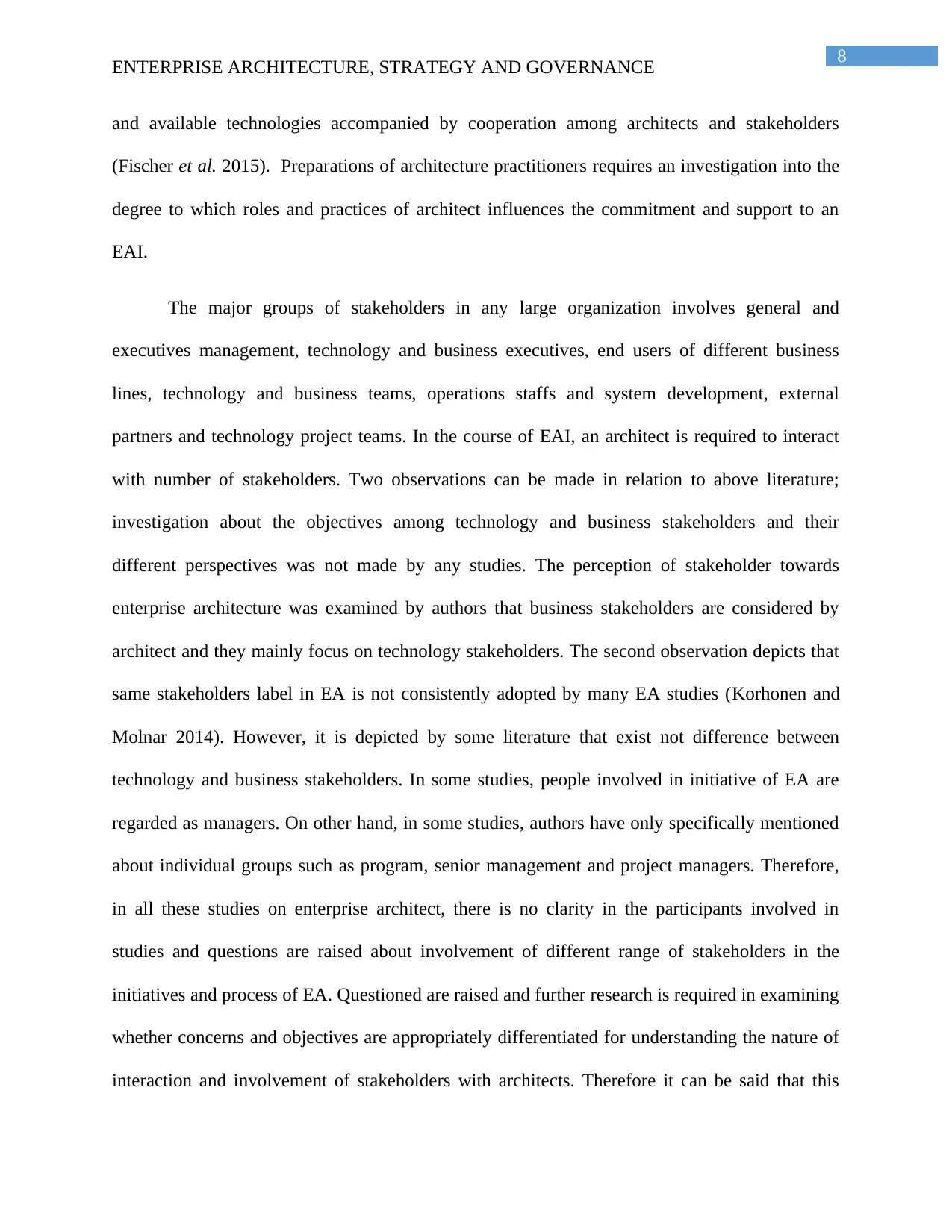
8
ENTERPRISE ARCHITECTURE, STRATEGY AND GOVERNANCE
and available technologies accompanied by cooperation among architects and stakeholders
(Fischer et al. 2015). Preparations of architecture practitioners requires an investigation into the
degree to which roles and practices of architect influences the commitment and support to an
EAI.
The major groups of stakeholders in any large organization involves general and
executives management, technology and business executives, end users of different business
lines, technology and business teams, operations staffs and system development, external
partners and technology project teams. In the course of EAI, an architect is required to interact
with number of stakeholders. Two observations can be made in relation to above literature;
investigation about the objectives among technology and business stakeholders and their
different perspectives was not made by any studies. The perception of stakeholder towards
enterprise architecture was examined by authors that business stakeholders are considered by
architect and they mainly focus on technology stakeholders. The second observation depicts that
same stakeholders label in EA is not consistently adopted by many EA studies (Korhonen and
Molnar 2014). However, it is depicted by some literature that exist not difference between
technology and business stakeholders. In some studies, people involved in initiative of EA are
regarded as managers. On other hand, in some studies, authors have only specifically mentioned
about individual groups such as program, senior management and project managers. Therefore,
in all these studies on enterprise architect, there is no clarity in the participants involved in
studies and questions are raised about involvement of different range of stakeholders in the
initiatives and process of EA. Questioned are raised and further research is required in examining
whether concerns and objectives are appropriately differentiated for understanding the nature of
interaction and involvement of stakeholders with architects. Therefore it can be said that this
ENTERPRISE ARCHITECTURE, STRATEGY AND GOVERNANCE
and available technologies accompanied by cooperation among architects and stakeholders
(Fischer et al. 2015). Preparations of architecture practitioners requires an investigation into the
degree to which roles and practices of architect influences the commitment and support to an
EAI.
The major groups of stakeholders in any large organization involves general and
executives management, technology and business executives, end users of different business
lines, technology and business teams, operations staffs and system development, external
partners and technology project teams. In the course of EAI, an architect is required to interact
with number of stakeholders. Two observations can be made in relation to above literature;
investigation about the objectives among technology and business stakeholders and their
different perspectives was not made by any studies. The perception of stakeholder towards
enterprise architecture was examined by authors that business stakeholders are considered by
architect and they mainly focus on technology stakeholders. The second observation depicts that
same stakeholders label in EA is not consistently adopted by many EA studies (Korhonen and
Molnar 2014). However, it is depicted by some literature that exist not difference between
technology and business stakeholders. In some studies, people involved in initiative of EA are
regarded as managers. On other hand, in some studies, authors have only specifically mentioned
about individual groups such as program, senior management and project managers. Therefore,
in all these studies on enterprise architect, there is no clarity in the participants involved in
studies and questions are raised about involvement of different range of stakeholders in the
initiatives and process of EA. Questioned are raised and further research is required in examining
whether concerns and objectives are appropriately differentiated for understanding the nature of
interaction and involvement of stakeholders with architects. Therefore it can be said that this
⊘ This is a preview!⊘
Do you want full access?
Subscribe today to unlock all pages.

Trusted by 1+ million students worldwide
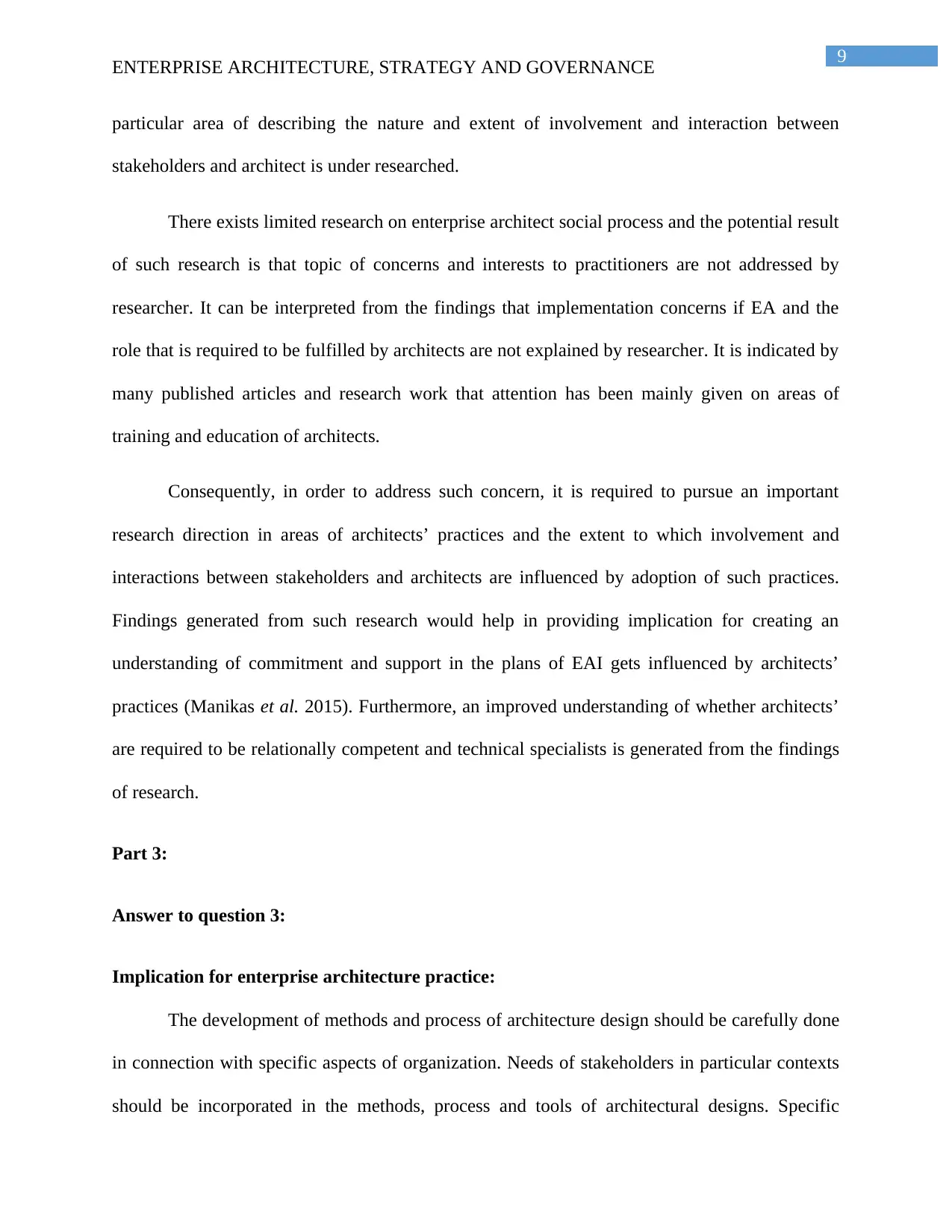
9
ENTERPRISE ARCHITECTURE, STRATEGY AND GOVERNANCE
particular area of describing the nature and extent of involvement and interaction between
stakeholders and architect is under researched.
There exists limited research on enterprise architect social process and the potential result
of such research is that topic of concerns and interests to practitioners are not addressed by
researcher. It can be interpreted from the findings that implementation concerns if EA and the
role that is required to be fulfilled by architects are not explained by researcher. It is indicated by
many published articles and research work that attention has been mainly given on areas of
training and education of architects.
Consequently, in order to address such concern, it is required to pursue an important
research direction in areas of architects’ practices and the extent to which involvement and
interactions between stakeholders and architects are influenced by adoption of such practices.
Findings generated from such research would help in providing implication for creating an
understanding of commitment and support in the plans of EAI gets influenced by architects’
practices (Manikas et al. 2015). Furthermore, an improved understanding of whether architects’
are required to be relationally competent and technical specialists is generated from the findings
of research.
Part 3:
Answer to question 3:
Implication for enterprise architecture practice:
The development of methods and process of architecture design should be carefully done
in connection with specific aspects of organization. Needs of stakeholders in particular contexts
should be incorporated in the methods, process and tools of architectural designs. Specific
ENTERPRISE ARCHITECTURE, STRATEGY AND GOVERNANCE
particular area of describing the nature and extent of involvement and interaction between
stakeholders and architect is under researched.
There exists limited research on enterprise architect social process and the potential result
of such research is that topic of concerns and interests to practitioners are not addressed by
researcher. It can be interpreted from the findings that implementation concerns if EA and the
role that is required to be fulfilled by architects are not explained by researcher. It is indicated by
many published articles and research work that attention has been mainly given on areas of
training and education of architects.
Consequently, in order to address such concern, it is required to pursue an important
research direction in areas of architects’ practices and the extent to which involvement and
interactions between stakeholders and architects are influenced by adoption of such practices.
Findings generated from such research would help in providing implication for creating an
understanding of commitment and support in the plans of EAI gets influenced by architects’
practices (Manikas et al. 2015). Furthermore, an improved understanding of whether architects’
are required to be relationally competent and technical specialists is generated from the findings
of research.
Part 3:
Answer to question 3:
Implication for enterprise architecture practice:
The development of methods and process of architecture design should be carefully done
in connection with specific aspects of organization. Needs of stakeholders in particular contexts
should be incorporated in the methods, process and tools of architectural designs. Specific
Paraphrase This Document
Need a fresh take? Get an instant paraphrase of this document with our AI Paraphraser
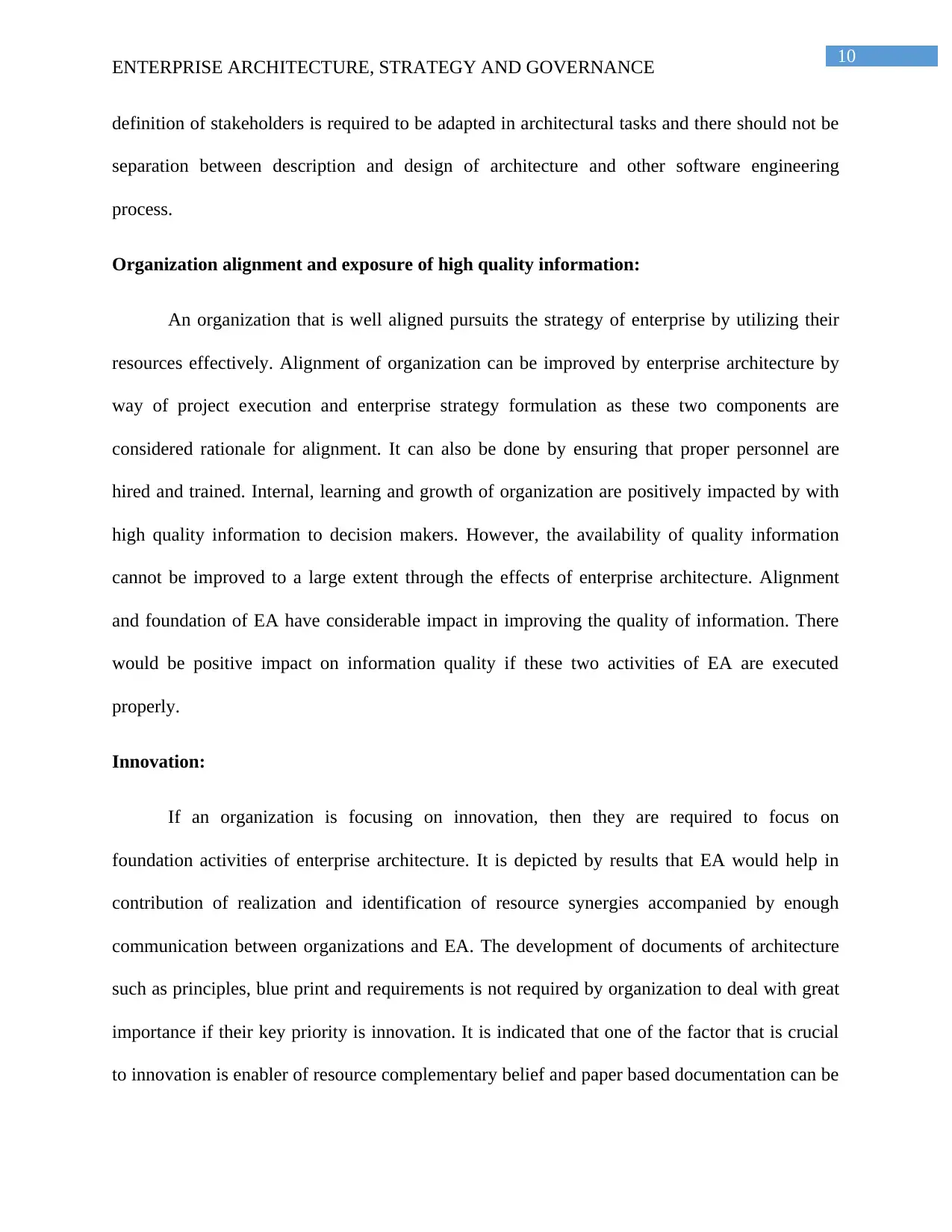
10
ENTERPRISE ARCHITECTURE, STRATEGY AND GOVERNANCE
definition of stakeholders is required to be adapted in architectural tasks and there should not be
separation between description and design of architecture and other software engineering
process.
Organization alignment and exposure of high quality information:
An organization that is well aligned pursuits the strategy of enterprise by utilizing their
resources effectively. Alignment of organization can be improved by enterprise architecture by
way of project execution and enterprise strategy formulation as these two components are
considered rationale for alignment. It can also be done by ensuring that proper personnel are
hired and trained. Internal, learning and growth of organization are positively impacted by with
high quality information to decision makers. However, the availability of quality information
cannot be improved to a large extent through the effects of enterprise architecture. Alignment
and foundation of EA have considerable impact in improving the quality of information. There
would be positive impact on information quality if these two activities of EA are executed
properly.
Innovation:
If an organization is focusing on innovation, then they are required to focus on
foundation activities of enterprise architecture. It is depicted by results that EA would help in
contribution of realization and identification of resource synergies accompanied by enough
communication between organizations and EA. The development of documents of architecture
such as principles, blue print and requirements is not required by organization to deal with great
importance if their key priority is innovation. It is indicated that one of the factor that is crucial
to innovation is enabler of resource complementary belief and paper based documentation can be
ENTERPRISE ARCHITECTURE, STRATEGY AND GOVERNANCE
definition of stakeholders is required to be adapted in architectural tasks and there should not be
separation between description and design of architecture and other software engineering
process.
Organization alignment and exposure of high quality information:
An organization that is well aligned pursuits the strategy of enterprise by utilizing their
resources effectively. Alignment of organization can be improved by enterprise architecture by
way of project execution and enterprise strategy formulation as these two components are
considered rationale for alignment. It can also be done by ensuring that proper personnel are
hired and trained. Internal, learning and growth of organization are positively impacted by with
high quality information to decision makers. However, the availability of quality information
cannot be improved to a large extent through the effects of enterprise architecture. Alignment
and foundation of EA have considerable impact in improving the quality of information. There
would be positive impact on information quality if these two activities of EA are executed
properly.
Innovation:
If an organization is focusing on innovation, then they are required to focus on
foundation activities of enterprise architecture. It is depicted by results that EA would help in
contribution of realization and identification of resource synergies accompanied by enough
communication between organizations and EA. The development of documents of architecture
such as principles, blue print and requirements is not required by organization to deal with great
importance if their key priority is innovation. It is indicated that one of the factor that is crucial
to innovation is enabler of resource complementary belief and paper based documentation can be
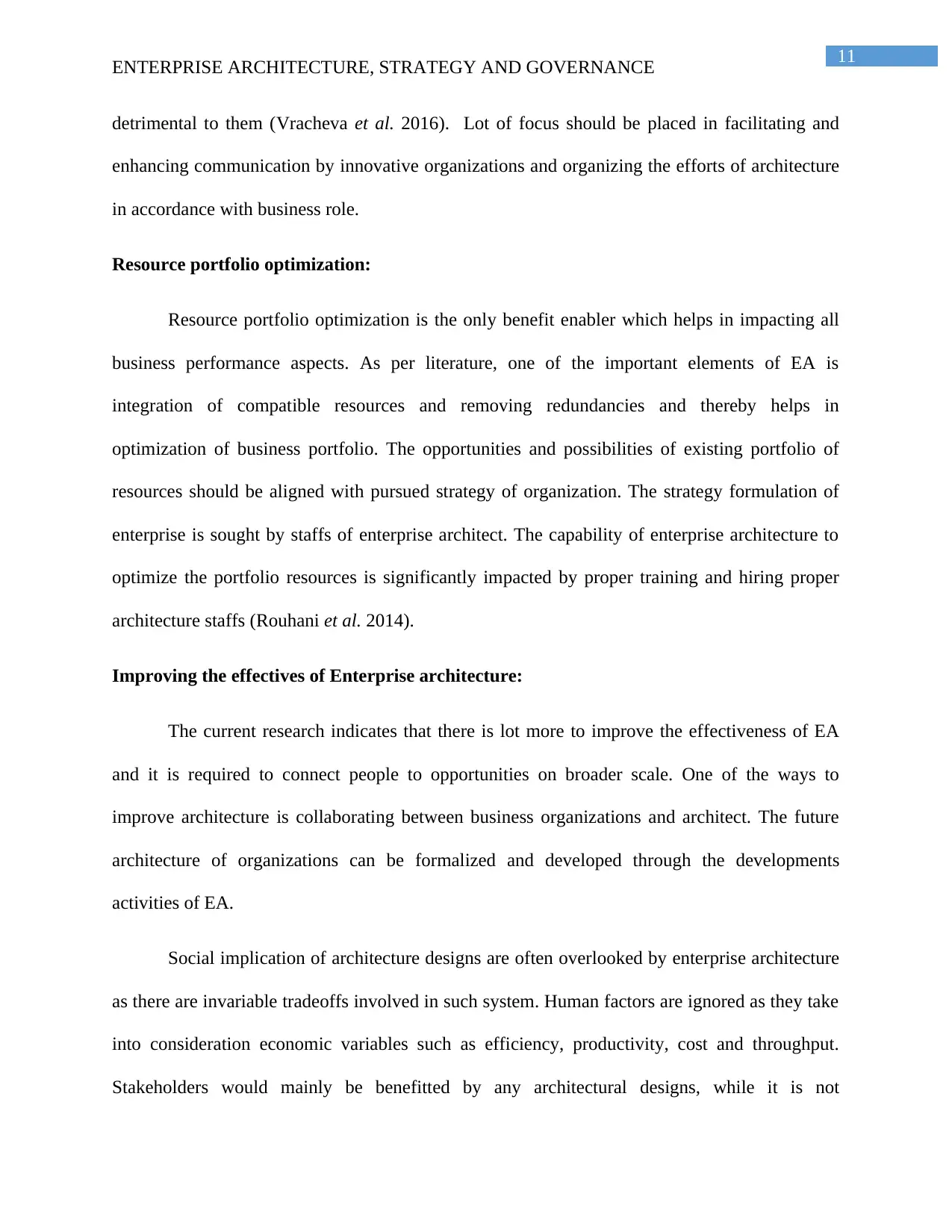
11
ENTERPRISE ARCHITECTURE, STRATEGY AND GOVERNANCE
detrimental to them (Vracheva et al. 2016). Lot of focus should be placed in facilitating and
enhancing communication by innovative organizations and organizing the efforts of architecture
in accordance with business role.
Resource portfolio optimization:
Resource portfolio optimization is the only benefit enabler which helps in impacting all
business performance aspects. As per literature, one of the important elements of EA is
integration of compatible resources and removing redundancies and thereby helps in
optimization of business portfolio. The opportunities and possibilities of existing portfolio of
resources should be aligned with pursued strategy of organization. The strategy formulation of
enterprise is sought by staffs of enterprise architect. The capability of enterprise architecture to
optimize the portfolio resources is significantly impacted by proper training and hiring proper
architecture staffs (Rouhani et al. 2014).
Improving the effectives of Enterprise architecture:
The current research indicates that there is lot more to improve the effectiveness of EA
and it is required to connect people to opportunities on broader scale. One of the ways to
improve architecture is collaborating between business organizations and architect. The future
architecture of organizations can be formalized and developed through the developments
activities of EA.
Social implication of architecture designs are often overlooked by enterprise architecture
as there are invariable tradeoffs involved in such system. Human factors are ignored as they take
into consideration economic variables such as efficiency, productivity, cost and throughput.
Stakeholders would mainly be benefitted by any architectural designs, while it is not
ENTERPRISE ARCHITECTURE, STRATEGY AND GOVERNANCE
detrimental to them (Vracheva et al. 2016). Lot of focus should be placed in facilitating and
enhancing communication by innovative organizations and organizing the efforts of architecture
in accordance with business role.
Resource portfolio optimization:
Resource portfolio optimization is the only benefit enabler which helps in impacting all
business performance aspects. As per literature, one of the important elements of EA is
integration of compatible resources and removing redundancies and thereby helps in
optimization of business portfolio. The opportunities and possibilities of existing portfolio of
resources should be aligned with pursued strategy of organization. The strategy formulation of
enterprise is sought by staffs of enterprise architect. The capability of enterprise architecture to
optimize the portfolio resources is significantly impacted by proper training and hiring proper
architecture staffs (Rouhani et al. 2014).
Improving the effectives of Enterprise architecture:
The current research indicates that there is lot more to improve the effectiveness of EA
and it is required to connect people to opportunities on broader scale. One of the ways to
improve architecture is collaborating between business organizations and architect. The future
architecture of organizations can be formalized and developed through the developments
activities of EA.
Social implication of architecture designs are often overlooked by enterprise architecture
as there are invariable tradeoffs involved in such system. Human factors are ignored as they take
into consideration economic variables such as efficiency, productivity, cost and throughput.
Stakeholders would mainly be benefitted by any architectural designs, while it is not
⊘ This is a preview!⊘
Do you want full access?
Subscribe today to unlock all pages.

Trusted by 1+ million students worldwide
1 out of 17
Related Documents
Your All-in-One AI-Powered Toolkit for Academic Success.
+13062052269
info@desklib.com
Available 24*7 on WhatsApp / Email
![[object Object]](/_next/static/media/star-bottom.7253800d.svg)
Unlock your academic potential
Copyright © 2020–2025 A2Z Services. All Rights Reserved. Developed and managed by ZUCOL.




